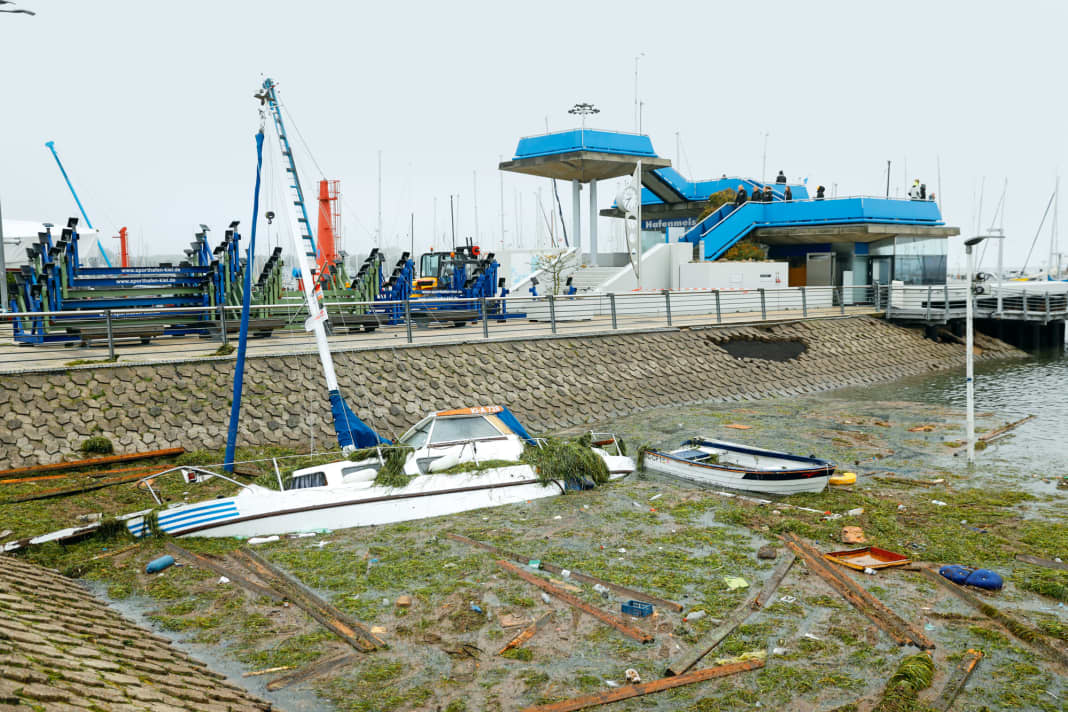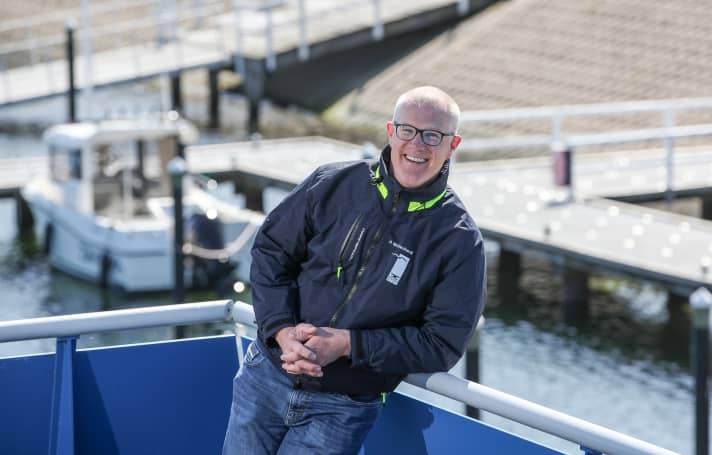





Mr Mühlenhardt, as head of nine marinas in Kiel, how do you feel when you see the many boat wrecks in Kiel-Schilksee?
Philipp Mühlenhardt: The extent of the damage we saw at dawn on Saturday was shocking, although I also realised that we were lucky: our floating docks in the north harbour were still in place and, more importantly, nobody was injured, even though some of the boat owners had actually spent the night on the boat.
In the morning, we had all available staff from our other harbours on site and, after a brief briefing, we began to survey the damage and sunken ships. Incidentally, we benefited from the fact that I personally called Holger Flindt from Pantaenius in Hamburg late on Friday evening with a premonition and asked him to send a salvage team.
Why do you think so many ships were damaged in the harbour?
In fact, the explanation for this disaster and the numerous accidents is somewhat complex. Some ships were moored incorrectly and sometimes with completely undersized or too few mooring lines. The breakaway of some of these ships then triggered a domino effect and dragged others with them. Boats torn loose destroyed jetties in the southern harbour, from which ships in turn broke free and damaged neighbouring vessels.
The force with which the forces acted also caused stern piles to break in some places and occasionally tore cleats with a complete concrete block out of the floating docks.
In addition, there were still a lot of boats in the water due to the rather warm September.
At the end of the day, however, you simply have to recognise that nature was at work with a force that ultimately could only be countered by a few people. The water level meant that the waves ran almost unchecked through the harbour basin and boats were washed up onto the harbour apron.
How could this catastrophe have been avoided?
It's hard to say. Even if we had received a forecast of the final water level and wind on Thursday, the disaster would probably have been almost impossible to prevent.
With today's knowledge, a higher stone pier, longer stern and retaining piles and floating jetties would probably have been built in the southern harbour. Certainly a key task for the future, which is unfortunately likely to be in the near future.
However, it is still a little too early for a final and conclusive assessment. However, we can already assure you that we will examine and discuss all conceivable measures.
Why were ships not moved from particularly dangerous berths, fixed jetties or across the wind direction?
We already pointed out the danger very early on our website. However, the fact that the run-up to the storm had already taken place in the middle of the week naturally meant that many working boat owners no longer had the opportunity to move their boats to the floating jetties in the north harbour. From Thursday onwards, every boat owner had to be advised not to attempt a passage close to the stone jetty in heavy seas and strong easterly winds. Incidentally, I would like to remind everyone that this is the responsibility of the boat owners, a fact that YACHT also regularly points out. However, we do not know why the owners have not moved their boats in individual cases.
Why weren't as many ships as possible taken out of the water on Tuesday and Wednesday, just a few days before the storm? In night shifts if necessary.
We craned continuously and at full capacity until the crane was shut down due to the weather on Thursday; on Wednesday, we even extended the crane operation into the evening hours. All our customers can expect safe craning and careful loading onto trailers or trestles. Our employees are well trained and have been doing their job for years without any damage or accidents. And every boat is given an appropriate time slot. It should be obvious to everyone that it gets dark at some point and that our employees are entitled to rest after a hard day's work.
Every boat owner would have had the opportunity to get their boat out of the water early. Autumn and bad weather don't come as a complete surprise. When boat owners now invoke so-called emergency cranes and accuse us of working according to the rules, this is a desperate attempt to find someone to blame and shift the responsibility for damage or even uninsured boats onto others.
And those who criticise the fact that their boat was not craned spontaneously would have expected to be given preference over scheduled cranings that had to be postponed the weekend before due to the weather.
While we had already extended our crane times in the evening hours on Wednesday, craning was already impossible on Thursday due to the weather. From Friday morning onwards, our employees were fully occupied with checking mooring lines and securing boats, sometimes jeopardising their health by trying to secure "strategically important boats" in order to prevent them from drifting away and causing damage to other boats. My request to my colleagues on Friday afternoon to organise a night shift with my support in order to be able to work throughout the night was immediately implemented. In the end, we cancelled it at 9.30 p.m. due to the acute danger to employees, but the willingness to do so was there immediately. To suggest that Sporthafen GmbH could have avoided the damage by craning out all the boats in good time is, with respect, remarkable.
Did the severity of the combination of storm and flooding surprise you and your team?
Obviously, not only we, but also the experts were surprised by the intensity. We had the gauge open all evening as a live image on the monitor and hoped that the curve would finally turn "right" at some point. The fact that it ended up being around 40 to 50 centimetres more and that the wind force also significantly exceeded the predicted level at 70 knots in some places was actually not expected. The damage to the Kiel lighthouse speaks for itself - steel doors were crushed by waves.
Do we need a warning system that effectively alerts the population to such storm surges in future?
A few years ago, we actually worked on just such a tool called RiscKIT as a practice partner in an EU-funded project together with the Federal Waterways Engineering and Research Institute (BAW). With the knowledge we have today, the question arises not only as to why the project was not translated into concrete practical measures at the time, but also whether the thread should not be picked up again now in order to at least establish an early warning system that gives those affected, whether boat owners or coastal residents, a little more reaction time.
What have you learnt from this event, what will change in Kiel-Schilksee?
I would like to take a more detailed look at our findings in three areas: Changes or adjustments to our infrastructure, what can be done on the boat owner side, and where can we improve communication, i.e. how can we reach boat owners in a more targeted and direct way in a timely manner.
The world's biggest sailing event, Kieler Woche, takes place in Schilksee at the end of June. Will you manage to rebuild by then?
I am encouraged by the speed with which we are currently making progress. We plan to have the harbour completely cleared by mid-November so that we will have a clear view of all the damage. We will then start the repair work promptly and I am optimistic that we will at least have all the berths available again for the next season. However, I wouldn't rule out the possibility that there will still be a few restrictions in the harbour, for example with the electricity and water supply.
But if we are back at the start in the 2024 season, it will also be thanks to the incredible commitment of those who have supported and will support us along the way. We couldn't have done it alone!

More about the Baltic Sea storm surge:
- Huge damage to the infrastructure
- Over 200 total losses - "Schilksee resembles a battlefield"
- Will the insurance companies pay for the damage?
- On board - Experiences during the night of terror
- All yachts must be salvaged by 31 October
- Dramatic depiction of the night of horror
- Pictures show the rescue by professionals

